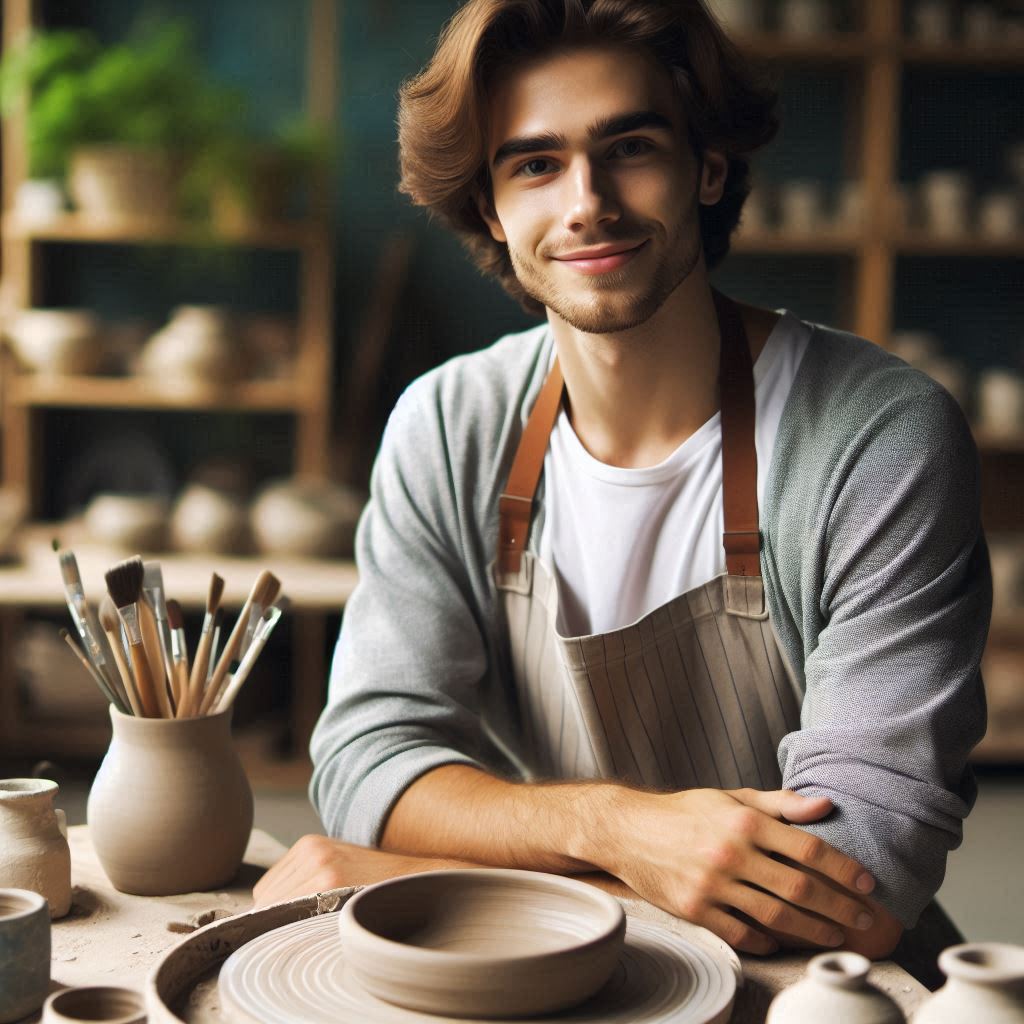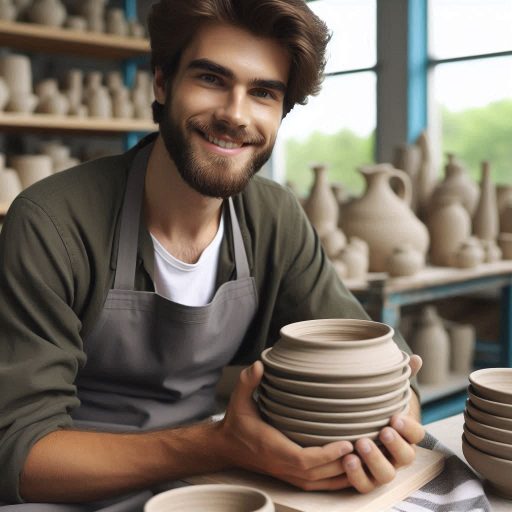Introduction
A glaze is a glass-like coating applied to pottery before firing, adding color, texture, and protection.
Importance of Understanding Glazes and Firing Techniques in Pottery
Understanding glazes and firing techniques is essential for creating beautiful and functional ceramic pieces.
Proper knowledge ensures the desired results, such as color intensity, smooth textures, and durability.
Each type of glaze and firing method can significantly impact the final outcome of a pottery piece.
Knowing how different glazes interact with various firing temperatures is crucial for successful pottery creation.
Experimenting with glazes and firing techniques allows artists to develop their unique style and aesthetic.
By understanding the science behind glazes and firing, potters can troubleshoot issues and improve their work.
Ultimately, mastering glazes and firing techniques opens up endless possibilities for creativity and artistic expression.
What are glazes?
Definition of glazes in pottery
Glazes in pottery are liquid coatings applied to ceramic ware before firing to create a desired finish.
They consist of silica, fluxes, and colorants that melt and form a glassy surface during firing.
Glazes serve both functional and aesthetic purposes in pottery, such as adding durability and enhancing visual appeal.
Types of Glazes
- Transparent glazes: Clear and glossy, allowing the color and texture of the clay body to show through.
- Opaque glazes: Solid and non-transparent, often used to cover imperfections or create solid color finishes.
- Matte glazes: Dull and non-reflective, offering a soft and subtle finish to ceramic pieces.
Role of Glazes in Pottery
Glazes provide a protective coating that makes ceramic ware impermeable to liquids and food-safe.
They enhance the appearance of pottery by adding vibrant colors, textures, and surface finishes.
Glazes can also alter the tactile qualities of pottery, such as creating a smooth or rough surface.
Read: Balancing Creativity and Business in Ceramic Art
Understanding firing techniques
Definition of Firing in Pottery
Firing techniques play a crucial role in the creation of ceramic pieces, affecting both the appearance and the durability of the final product.
Firing in pottery refers to the process of heating ceramic materials in a kiln to transform them into a solid, durable form.
Different Types of Firing Techniques
- Oxidation Firing: In oxidation firing, the kiln atmosphere has an abundance of oxygen, which produces bright and vibrant colors in the glazes.
- Reduction Firing: Reduction firing occurs in a kiln with a limited oxygen supply, creating unique effects on glazes such as metallic finishes and variegated colors.
- Salt/Soda Firing: Salt/soda firing involves adding salt or soda to a kiln during the firing process, resulting in a textured, orange-peel surface on the pottery.
Importance of Firing Techniques in Pottery
The choice of firing technique can impact the final look and quality of the ceramic piece in several ways:
- Color Variation: Different firing techniques produce different color effects on the glazes, allowing artists to achieve their desired aesthetic.
- Texture and Surface: Firing techniques can influence the texture and surface quality of the pottery, ranging from smooth and glossy to rough and matte.
- Strength and Durability: Proper firing techniques ensure that the ceramic piece is heated to the right temperature for optimal strength and durability.
- Chemical Reactions: The atmosphere inside the kiln during firing can lead to chemical reactions that result in unique patterns and finishes on the pottery.
- Creative Expression: Artists can experiment with different firing techniques to express their creativity and create one-of-a-kind pieces that stand out.
Understanding firing techniques is essential for any ceramic artist looking to create high-quality, visually stunning pottery pieces.
By mastering how different firing methods can affect the final outcome, artists can unleash their creativity and produce exceptional works of art.
Transform Your Career Today
Unlock a personalized career strategy that drives real results. Get tailored advice and a roadmap designed just for you.
Start NowFactors to consider when choosing glazes
Color options and finishes
When choosing glazes, one of the key factors to consider is the color options and finishes available.
Different glazes offer a wide range of colors, from vibrant and bold to subtle and earthy tones.
Consider the overall look you want to achieve and choose glazes that will complement your aesthetic.
Food safety considerations
Another important factor to think about when selecting glazes is food safety.
If you plan on using your pottery for food or drink, make sure to choose glazes that are food-safe and free from harmful chemicals.
Look for glazes that are labeled as non-toxic and lead-free to ensure the safety of your ceramic pieces.
Compatibility with firing techniques
Lastly, consider the compatibility of the glazes with your firing techniques.
Some glazes are designed for specific firing temperatures and methods, so it’s essential to choose glazes that will work well with your firing process.
Make sure to read the instructions provided by the manufacturer to determine the best firing range for the glazes you plan to use.
Read: Networking Tips for Emerging Ceramic Artists
Steps for Applying Glazes
When it comes to applying glazes to your pottery pieces, there are several important steps to follow to ensure a successful outcome.
Below are the key steps involved in the glazing process:
Surface Preparation
Start by cleaning your pottery piece thoroughly to remove any dust, dirt, or residue that may be present on the surface.
Next, consider sanding the surface of the pottery to create a smoother texture and ensure better adhesion of the glaze.
Make sure the pottery is completely dry before moving on to the next step to prevent any issues with the glaze application.
Applying Glazes
There are various methods for applying glazes to pottery, including dipping, brushing, and spraying.
Dipping involves submerging the pottery piece into a bucket of glaze to coat the entire surface evenly.
Brushing allows for more controlled application of the glaze, especially for intricate designs or patterns.
Spraying is another technique that provides a smooth, even application of the glaze for a professional finish.
Whichever method you choose, make sure to apply multiple layers of glaze if desired, allowing each layer to dry before adding the next one.
Transform Your Career Today
Unlock a personalized career strategy that drives real results. Get tailored advice and a roadmap designed just for you.
Start NowFiring Process After Glaze Application
Once you have applied the glazes to your pottery pieces, it’s time to fire them in a kiln to achieve the desired finish.
Follow the specific firing instructions for the type of glaze you have used, as different glazes require different firing temperatures and durations.
Make sure to load the kiln carefully to prevent any pieces from touching and sticking together during the firing process.
Monitor the kiln temperature throughout the firing process to ensure that it remains consistent and reaches the desired temperature for the glazes to mature properly.
After the firing process is complete, allow the pottery pieces to cool slowly in the kiln before removing them to prevent thermal shock and potential cracks.
By following these steps for applying glazes and understanding the firing techniques involved, you can create beautifully finished pottery pieces that showcase your creativity and craftsmanship.
Read: How to Sell Your Printmaking Art Online

Common glazing mistakes to avoid
When it comes to glazes and firing techniques, there are certain common mistakes that beginners and even experienced potters can make.
Being aware of these pitfalls can help you avoid them and achieve better results in your ceramic creations.
Overloading glazes
One common mistake is applying too much glaze to your piece.
This can result in drips, uneven coverage, and even running during firing.
To avoid this, make sure to apply glazes in thin, even layers.
Before glazing your piece, consider the thickness of the glaze and how it will interact with other glazes on the surface.
Experiment with different application techniques to achieve the desired effect without overloading the glazes.
Inconsistencies in glaze application
Another mistake to watch out for is inconsistencies in glaze application.
This can result in variations in color, texture, and finish on your piece.
To avoid this, make sure to apply glazes evenly and consistently.
Before applying glazes, prepare your piece properly by cleaning and drying it thoroughly.
Use the right tools for the job, such as brushes, sponges, or sprayers, to ensure an even application of glaze.
Take your time and pay attention to details to achieve a uniform finish.
Transform Your Career Today
Unlock a personalized career strategy that drives real results. Get tailored advice and a roadmap designed just for you.
Start NowNot following the proper firing schedule
One of the most important aspects of working with glazes is following the proper firing schedule.
Failure to adhere to the recommended temperature and timing can result in under- or over-fired pieces, leading to disappointment and wasted effort.
Before firing your pieces, carefully read the instructions for the glazes you are using and follow the recommended firing schedule.
Keep track of the temperature in the kiln and make adjustments as needed to ensure a successful firing.
Properly cooling your pieces after firing is also crucial to avoid cracks and other issues.
Avoiding these common glazing mistakes can help you improve your ceramic art and achieve the results you desire.
Remember to practice, experiment, and learn from your experiences to become a more skilled potter.
Read: Exploring Ceramic Art: Trends and Innovations
You Might Also Like: Textile Designer Salary: What You Need to Know
You Might Also Like: How to Land Your First Game Design Job
Troubleshooting glaze and firing issues
When working with glazes and firing techniques, it is common to encounter issues that can affect the final outcome of your pottery.
Understanding these common problems and knowing how to fix them is essential in creating successful ceramic pieces.
Understanding common problems
- Pinholing: Small holes in the glaze caused by gases escaping during firing.
- Crawling: When the glaze pulls away from the surface, leaving bare patches.
- Blistering: Bubbles forming in the glaze due to trapped gases or moisture.
Identifying these issues early on can help you take the necessary steps to prevent them from affecting your pottery.
Tips for fixing glaze and firing problems
- Adjust your firing schedule: Slow down the firing process to allow gases to escape properly.
- Apply thinner coats of glaze: Thick layers can lead to crawling and blistering.
- Smooth out the surface: Sanding or polishing the bisqueware before glazing can prevent issues.
- Control moisture: Make sure your pottery is completely dry before firing to avoid blistering.
By implementing these tips, you can improve the overall quality of your ceramics and prevent common glaze and firing issues.
Consulting with experienced potters or technicians for assistance
If you continue to experience problems with your glazes or firing techniques, don’t hesitate to seek help from experienced potters or technicians.
They can offer valuable advice and guidance based on their expertise and knowledge in the field.
Collaborating with others in the pottery community can provide you with new insights and solutions to the challenges you may be facing.
Don’t be afraid to ask for help and learn from those who have more experience in the craft.
Remember, troubleshooting glaze and firing issues is a common part of the ceramic process, and by seeking help and implementing the right techniques, you can overcome these challenges and create beautiful pottery pieces that you can be proud of.
Find Out More: Essential Tools Every Product Designer Should Use
Transform Your Career Today
Unlock a personalized career strategy that drives real results. Get tailored advice and a roadmap designed just for you.
Start NowExperimenting with glazes and firing techniques
When it comes to experimenting with glazes and firing techniques, there are several key elements to keep in mind to achieve desired results.
Trying out new glaze combinations
One of the most exciting parts of working with ceramics is the endless possibilities when it comes to mixing and matching different glazes.
By experimenting with various glaze combinations, you can create unique and innovative finishes on your pottery pieces.
Don’t be afraid to step out of your comfort zone and try something new.
Testing different firing temperatures and methods
The firing process plays a crucial role in determining the final outcome of your ceramics.
By testing different firing temperatures and methods, such as oxidation or reduction firing, you can discover how these factors influence the appearance of your glazes.
Keep detailed notes on each firing experiment to track your results and make adjustments accordingly.
Keeping a glaze journal to track results
It’s essential to keep a glaze journal where you can record the recipes, application techniques, firing temperatures, and results of each glaze experiment.
By maintaining a detailed record of your glaze tests, you can easily replicate successful combinations and learn from any mistakes along the way.
A glaze journal will also help you identify patterns and trends in your work, allowing you to refine your techniques over time.
Experimenting with glazes and firing techniques is a rewarding process that allows you to unleash your creativity and push the boundaries of traditional ceramics.
By exploring new possibilities and keeping track of your results, you can enhance your skills as a ceramic artist and develop a signature style that sets your work apart.
Conclusion
Understanding glazes and firing techniques is essential for creating successful pottery pieces.
Remember to experiment with different combinations to achieve unique results.
Key points include the importance of glaze application, the impact of firing temperatures on the final outcome, and the need for proper ventilation in the kiln.
Continuing to learn and try new techniques will help enhance your pottery skills and expand your artistic possibilities.
Don’t be afraid to explore and push boundaries!




